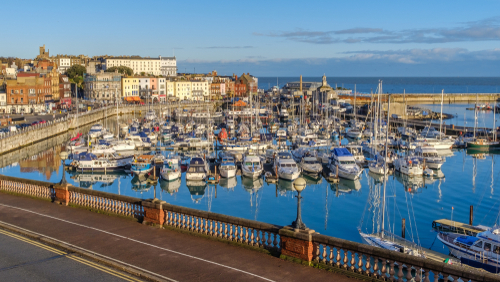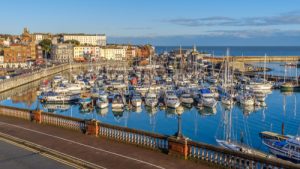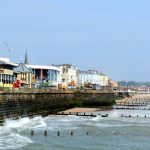
Ramsgate is a seaside resort in East Kent on the south coast of England. Situated on the English Channel, the town lies approximately 15 miles north-east of Canterbury and 15 miles north of Dover. For may years, Ramsgate operated a busy cross-channel ferry service. Today, much of the town’s ex-port has been transformed into one of the largest marinas in the South of England. The recorded population of Ramsgate at the 2011 National Census was 40,408.

Image Credit: Christine Bird/Shutterstock.com
Ramsgate A Fleeting History
The Town started out as a fishing and farming hamlet in early Medieval England. The Christian missionary St. Augustine landed in Ramsgate on his arrival to England in 597 AD. He famously converted the pagan Anglo-Saxon King Aethelbert of Kent to Christianity shortly after his arrival.
The earliest known mention of Ramsgate is made in the Kent Hundred Rolls (district survey) of 1274 – 75. In the document, the town’s name is entered as ‘Ramisgate’ or ‘Remmesgate’. The name is derived from the Anglo-Saxon words ‘hremmes'(raven’s) and ‘geat’ (gate), the latter referring to the local break in the cliffs.
By 1360, Ramsgate as it was known by then, had developed little down the centuries, still being nothing more than a fishing and farming hamlet. However, in 1483, it received a boost in its standing when it was adopted as a ‘limb port’ of Sandwich, and thus, became a member of the Confederation of Cinque Ports.
The Confederation had started out with the five south coast settlements of Dover, Hastings, Hythe, New Romney and Sandwich, as members. They were strategically grouped together by Edward the Confessor in the 11th century for defence purposes. However, despite its new-found status, nothing was to drastically change for the town and its inhabitants for the next few hundred years.
The Georgian & Victorian Era
Ramsgate’s development did not really gain momentum until 1749 when work began on improving its maritime facilities. The need was highlighted by a violent storm, which struck the south coast the year previous. This prompted the Royal Navy into securing a refuge harbour in the area to better manage such future events. Tourists were soon to follow the navy’s presence in the town.
In 1754, it’s documented that it got its first bathing machine. These were simply carts, fitted with a canopy, which could be lowered into the sea to allow bathers to enter the water in private. Ramsgate soon became a favoured sea-bathing place for wealthy visitors. Assembly rooms, coffee houses and health spas soon opened, further enhancing the town’s popularity with its well-to-do visitors. In 1785, an Act of Parliament was obtained to form a ‘Board’, responsible for improving the town’s streets and providing a market hall.
During the Napoleonic Wars of the early 19th century, Ramsgate became a major embarkation point for troops leaving for the continent. In 1820, King George IV sailed from the town with the Royal Squadron on his way to Hanover. King George, it seems, was elated with the reception he’d received here and subsequently decreed that it should be given ‘Royal Harbour’ status – a unique accolade. In the 1820s, the town’s reputation as a fashionable resort was further enhanced when the future queen, Princess Victoria, chose to stay a number of times.
Here Comes The Train
In 1846, the railway first reached Ramsgate when the South Eastern Railway (SER) opened its line from Canterbury. Later in the same year, a second line opened, linking Ramsgate with its rival resort, Margate, five miles away.
In 1863, Ramsgate’s Harbour station opened as the terminus on the London Chatham and Dover Railway (LCDR), when the extension from Herne Bay was completed. With a train station conveniently situated right next to the beach, visitors flocked to the town in ever-increasing numbers. Some of Ramsgate’s famed 19th-century visitors included the likes of George du Maurier, Vincent Van Gogh, Wilkie Collins and Jane Austen.
In 1901, Kent’s District of Thanet saw the introduction of electric tram services. The 11 miles of track linked up Ramsgate with Margate and Broadstairs.
The War Years
The First World War had a great impact on both Ramsgate’s fishing and tourist industry. The town was immediately made off-limits to tourists and the English Channel obviously became a dangerous place to be for a fishing boat. Thus, many of the town’s fishing fleet quickly moved to operate from other ports. Ramsgate’s harbour became one of the bases for the eclectic mix of fishing boats, tugs and newly-built minesweepers, that made up the Dover Patrol.
However, the town’s military presence and it’s proximity to Europe made it a prime target for bombing by the German Zeppelin airships and Gotha bombers, as well as shelling from naval warships. This culminated in Ramsgate gaining a reputation as being the UK’s most bombed seaside town during the conflict.
As the outbreak of WW2 looked likely to become reality, Ramsgate’s Borough Council decided to embark on a plan to create a network of deep shelter tunnels. The tunnels were to link with an existing railway tunnel, with the aim of providing shelter against German bombardment for the town’s civilian population. The tunnels were opened on 1 June 1939.
WWII Ramsgate
In October 1939, the Royal Navy opened HMS Fervent, a coastal defence base at Ramsgate. Torpedo boats, gunboats and motor launches operated out of the base throughout the rest of the war. Between May 26 and June 4, 1940, some 850 private boats (‘the little ships’) set sail from Ramsgate, as part of the allied WW2 Operation Dynamo. They helped in the rescue of more than 336,000 British and French soldiers who were trapped on the beaches at Dunkirk. The town proved to be second only to Dover in terms of handling Dunkirk returnees, which proved to be some 80,000.
Ramsgate paid a heavy price during WW2, being a target for both aerial bombing and naval shelling. The most infamous incident occurred during August 24th 1940, when it was reported that the Luftwaffe had dropped 800 bombs on the town in the space of 5 minutes. More than 1200 homes were destroyed, and 29 civilians, along with 2 soldiers, were killed. Around 300 families moved to ‘The Tunnels’ on a permanent basis, where they saw out the rest of the war.
The Modern Era
Ramsgate operated cross-channel ferries for many years, however, the last service, running to Oostende, ceased in April 2013. Today, Ramsgate’s important industries are tourism and fishing. Though, fishing is mostly carried out by single-man crewed boats and is essentially in decline. The town also has a thriving marina with over 800 moorings. Thus, a range of marine-related businesses also operates in the town.
The town’s colleges also provide extensive education services for students learning English as a foreign language. An emerging industry in the area is offshore power generation. Thanet’s offshore wind project is eventually expected to provide up to 800 local jobs.
Ramsgate market is held in the town’s High Street, King Street and Queen Street, every Friday and Saturday. The town’s popular annual regatta is held in late July and hosted by the Royal Temple Yacht Club. The Ramsgate Carnival is another annual event that takes place during the summer months. The annual Addington Street Revival Fair is a relatively new but popular event, taking place towards the end of summer.
Ramsgate is twinned with Conflans-Sainte-Honorine in France; Chimay in Belgium; and Frederikssund in Denmark.
Getting to Ramsgate
By Road
From almost everywhere in the country to get to Ramsgate, it best to head to London first. There are excellent road links to Ramsgate from London, via both the M20 and M2 motorways. From London, the shortest route is via the A2/M2/A299.
By Bus
From almost all UK destinations it will be easiest to head to London first to complete any bus trip to Ramsgate. There are around 60 coaches per day that make the 70 mile trip between London and Ramsgate. The minimum journey time is about 2 hrs and a maximum of around 2 hrs 40 mins. You can catch a coach from both London Victoria and Liverpool Street train stations.
By Train
There are around 140 trains per day between London and Ramsgate, leaving from St Pancras (International), Charing Cross and London Victoria. The approximate 70-mile journey generally takes around 2 hours, although the fastest train takes about 1 hour 15 minutes.
By Air
The nearest airport to Ramsgate is Southend Airport, which is 35 miles away, but it has a very limited flight schedule. The next nearest is London City Airport, about 60 miles away, which has domestic and European flights only. The nearest major international airport is London Gatwick, which is 70 miles away.
Did you know?
- It’s often cited that Ramsgate’s Pegwell Bay was the initial landing place of the invading Saxons in 449 AD.
- Ramsgate has the unique accolade of being the only place in the UK that has a ”Royal Habour”.
- In 1854, Queen Victoria bought the ‘Ramsgate Sands’ painting by acclaimed 19th-century artist W. P. Frith.
- Ramsgate town has a small population of feral parakeets. Some theorise that the birds originally arrived in the town in the 19th century, being escaped pets from foreign ships docking at the port.
Notable People
A few notable people with connections to Ramsgate include:
- Brenda Blethyn OBE – is a renowned TV and film actress whose career started in 1980. Since then, she has received a number of accolades, including a Golden Globe, a BAFTA, a Cannes Film Festival Award and two Academy Award nominations. She is arguably best known for playing the leading role of DCI Vera Stanhope in the British crime drama ‘Vera’. Brenda was born in Ramsgate on the 20 February 1946.
- John Le Mesurier (1912 – 1983) – was born John Elton Le Mesurier Halliley in Bedford on 5 April 1912. He was a renowned actor whose career began in 1934 and lasted up until 1980. He appeared in some 120 films, mostly as a supporting actor. However, he is almost certainly best remembered for his role as Sergeant Wilson in the BBC’s TV popular sitcom ‘Dad’s Army’ (1968–1977). John moved to 8 London Road, Ramsgate in 1970, where he lived until his death in 1983.
- Gary Pallister – is a former professional footballer and a TV pundit. His football playing career lasted from 1984 to 2001. He most notably played for Manchester United between 1989 and 1998, and England between 1988 and 1996, gaining 22 caps. He also played for Middlesbrough and Darlington. He was born in Ramsgate on 30 June 1965 but moved to Norton in County Durham, while still a young child.
Sport In Ramsgate
Whether you favour the round or oval ball Ramsgate has something to offer:
Ramsgate FC
Ramsgate FC currently plays in the Isthmian League South East Division. Nicknamed (un-originally) ‘The Rams’ they play their home games at the Southwood Stadium.
Thanet Wanderers RUFC
Thanet Wanderers RUFC are based about 2 miles out of Ramsgate at Broadstairs. The first XV currently play in London and South East Division 2. They play home games at St Peter’s Recreation Ground.
Things to do in Ramsgate
A few recommended things to do in Ramsgate include:
- Pegwell Bay National Nature Reserve – is a must for anyone interested in bird watching and nature. There are several guided walks that can be undertaken in the Ramsgate and Pegwell Bay area. Lots of different species of birds can be spotted at the site throughout the year. However, Spring is Autumn particularly good, when large migratory flocks pass through the area.
- Main Sands – is Ramsgate’s centrally-located Blue-Flag sandy beach. Within a short stroll, there are the expected seaside facilities, i.e. arcades, amusements and plenty of places to eat and drink. The Victorian Royal Pavilion is also close at hand, which is now a pub.
- Kayaking – local specialist operators offer a ‘guided wildlife safari’. It’s a seawater paddle between Ramsgate and the Pegwell Bay National Nature Reserve. There you’ll find an abundance of seals and birdlife, with spectacular views along the way.
- Kitesurfing – Ramsgate is said to be the perfect location for kitesurfing, so it’s your big opportunity to give the sport a go for yourself. Kite schools offer lessons for beginners and coaching for experienced kitesurfers who are looking to improve their skills.
- Boat trips – There are plenty of operators who will take you on a trip around the harbour or further afield. There’s also a range of available boat trips around the coast, including ones to the famous Goodwin sands. There’s also seal and wildlife trips, wind farm trips, and bay & beach trips
- The Viking Coastal Trail – is a mostly traffic-free, gently rolling 25-mile circular cycling and walking trail, that loops around the District of Thanet. Starting out from Ramsgate you can follow the coast by heading north towards Broadstairs and takes in Margate as well as several other Kent coastal towns.
Things to see in Ramsgate
Some of the things definitely worth seeing are:
- The famed Ramsgate Tunnels – excavated in the chalk beneath the town’s streets during WW2 to provide shelter against German bombing. You can take a guided tour of all 2.5 miles of them from Wednesday to Sunday. The guides have plenty of wartime anecdotes and There’s also an exhibition of wartime artefacts and a café.
- The Royal Harbour – is the only official ‘Royal’ harbour in the UK, a title bestowed in 1821 by King George IV. A few things of interest to see around the harbour include; the clock house, the lighthouse on the West Pier, Jacob’s Ladder stairs, and the obelisk on the quayside that commemorates the king’s visit.
- Spitfire and Hurricane Memorial Museum – is situated a few minutes away from town at the former World War 2 RAF Manston base. The aviation museum’s main attractions are a perfectly restored Spitfire and Hurricane from the Second World War. However, there’s also plenty of wartime artefacts and memorabilia as well as a café.
- Ramsgate Maritime Museum – can be found in the spectacular Clock House, located in the Royal Harbour. The museum is dedicated to the area’s maritime history. There are 4 galleries with permanent displays, which tell the stories of the town’s harbour, and the area’s navigation, fishing, lifeboats and shipwrecks. A 5th gallery houses various temporary exhibitions, including those of visiting artists.
- St Augustine’s Church – is of Gothic Revival architecture. It was designed by Augustus Pugin, who also designed the Palace of Westminster. Work started in 1846, and though Pugin died in 1852, his sons went on to eventually finish the project a few decades later. The church is dedicated to St Augustine, generally credited as being the first person to preach the Christian faith in Britain.
Where to stay?
Inns and small hotels form the majority of the readily available type of accommodation in Ramsgate at the lower end of the market. Higher priced accommodation, usually large hotels, obviously bring more luxury. Family rooms and apartments are also readily available, which generally offer value for money if you are travelling in a group. At only 2 miles and 4 miles away respectfully, Broadstairs and Margate offer practical alternatives to staying in Ramsgate, although prices are similar. A broad price guide for an overnight stay in the town for 2 adults sharing is:
Inn/B & B/Guesthouse/Lodge/Hotel: £60 – £100
Luxury Hotel: £100 – £200
Thinking of moving?
Are you thinking of moving to Ramsgate? Over the last 12 months, properties in Ramsgate have fetched an overall average price of £233,800. The best selling properties in the last year were terraced houses, selling for an average price of £230,700. Flats sold for an average of £166,500, semi-detached properties for £254,700, with detached properties fetching £317,800. Overall, the average property in Ramsgate, in the last 12 months, sold for 3% more than in the previous year.
So there you have it our Five Minute Guide to this lovely Seaside Town, Before you go why not check out another of our growing range of guides of if general knowledge is your thing try some of our quizzes.
Don’t forget to join our growing community it’s free and could be very rewarding going forward.




